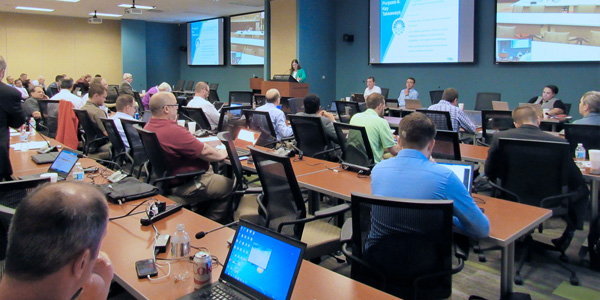CARMEL, Ind. — Capacity prices last month cleared at just $1.50/MW-day across MISO because of increased supply and low demand, John Harmon, MISO senior manager of capacity market administration, said during a post-mortem of the RTO’s April capacity auction. (See All Zones at $1.50/MW-day in 5th MISO Capacity Auction.)

Coal accounted for most of the auction’s 135 GW of cleared capacity at 53,332 MW, followed by natural gas (48,784 MW) and nuclear (12,885 MW).
A key factor in depressing demand and prices: the overall rise in self-scheduled offers and fixed resource adequacy plans (FRAPs), which increased by more than 10% in zones 4 and 8.
Speaking at a May 10 meeting of the Resource Adequacy Subcommittee, Harmon said changes in offering behavior flattened the offer curve compared with last year’s auction, which saw prices clear at $2.99/MW-day in MISO South, $19.72/MW-day in Zone 1 and $72/MW-day in zones 2, 3, 4, 5, 6 and 7.
Indianapolis Power and Light’s Ted Leffler pointed out that many offers in this year’s auction came in at less than a dollar, with some entered at just a penny.

“There were no instances of mitigation for physical or economic withholding,” Harmon confirmed.
American Electric Power’s Kent Feliks wondered if MISO had to contact any resources in order to enforce a new rule that imposes a 50-MW physical withholding ceiling on affiliated market participants collectively, rather than on each affiliated company individually. The new rule won tentative FERC approval mid-March with forewarning that the rule may not be just or reasonable. (See FERC Staff OKs MISO Mitigation Changes; Refunds Possible.)
“There were a few phone calls, largely from late offers,” Harmon said, noting that some resources bid into the auction near the end of the three-day offer window.
“MISO acting as a conduit to affiliates makes us a little uneasy,” Feliks replied.
Some stakeholders have argued that FERC Order 697 already prohibits affiliates from colluding to dodge withholding mitigation and MISO and its Independent Market Monitor’s new rule is unjustified. (See MISO Plans Additional Capacity Auction Revamps for 2017.)
RASC Chair Chris Plante expressed surprise that stakeholders didn’t have more to say about the auction results, given the low clearing prices.
Stakeholders Won’t Debate Single Year of MISO-SPP Settlement
Stakeholders voted overwhelmingly to end debate about whether costs for MISO’s transmission use settlement with SPP should be allocated by capacity benefit to holders of transmission service requests above the 1,000-MW contract path linking MISO Midwest to MISO South.
Laura Rauch, MISO manager of resource adequacy coordination, said the RTO agreed that the allocation amounts in question were too small to warrant more presentations and feedback cycles.

The RTO had previously asked stakeholders about holding discussions about how to allocate costs for the 300 MW in requests for 2018/19 that exceed the current limit on the North-South interface. Staff warned that the cost split may be negligible, and the matter was put to a stakeholder vote last month via a motion prepared by the Load-Serving Entity Coalition. (See “Single Year of SPP-MISO Settlement Allocation on Ballot,” MISO Resource Adequacy Subcommittee Briefs.)
MISO to Keep Current OMS Survey Format
MISO will stick with using the existing format for its annual resource adequacy survey with the Organization of MISO States, while examining next year’s project estimate approach in light of a new interconnection queue process, RTO staff said.
Rauch said that while stakeholders had not reached consensus on how to display survey results, most believe the RTO should do more to emphasize a fuller range of capacity possibilities. Staff were considering a “floating” results format, but it failed to garner stakeholder favor. (See “MISO Still Tweaking OMS-MISO Survey Format,” MISO Resource Adequacy Subcommittee Briefs.)

MISO is still uncertain about how survey results will be affected by the roll-out of FERC-approved improvements to the interconnection queue, which could increase capacity counts through a quicker turnaround of project approvals. Rauch said it will continue to look into revising its project estimates in future surveys.
This year, MISO and OMS will count 35% of projects in the definitive planning phase of the queue toward future available capacity, in addition to the typical counting of all generation projects with signed interconnection agreements. The new approach was announced after multiple stakeholders voiced displeasure at what they saw as overly conservative results. (See OMS-MISO Survey Moves Ahead with New Calculation.)
Attorney Jim Dauphinais, speaking on behalf of Illinois Industrial Energy Consumers, said trade press and policymakers tend to take zonal capacity projections at their word and ignore the import capability of neighboring zones, which can solve capacity shortfalls.
“Those are negative amounts, and there is some concern with that, but import capability can solve that, and somehow that needs to come through so that policymakers aren’t left with the impression that this is a big problem,” Dauphinais said. “I think sometimes the press and policymakers miss” import capability. He also suggested that MISO post results by state rather than by local resource zones.
Ted Kuhn of Customized Energy Solutions said that even the scaling of the shortfalls versus surpluses on the findings graph is off, with shortfalls drawn visibly larger than their identical surplus counterparts in 2016 results. Rauch examined the graph and agreed that shortfalls were exaggerated in illustrations.
MISO and OMS will present results of the survey mid-June.
MISO to Study Effects of Extended Outages
MISO is still considering whether to bar resources on extended outages from participating in Planning Resource Auctions — or to make changes to capture the risk of such outages in its loss-of-load expectation (LOLE) analyses.
Harmon said the RTO will review its current LOLE study against actual recent outages and present results to stakeholders by mid-July.
MISO’s Tariff does not currently prohibit auction participation for resources on outages for 90 days up to the entire planning year. Staff last month asked stakeholders to suggest maximum outage lengths that would disqualify a resource from PRA participation. (See MISO May Bar Units on Extended Outage from Capacity Auctions.)



